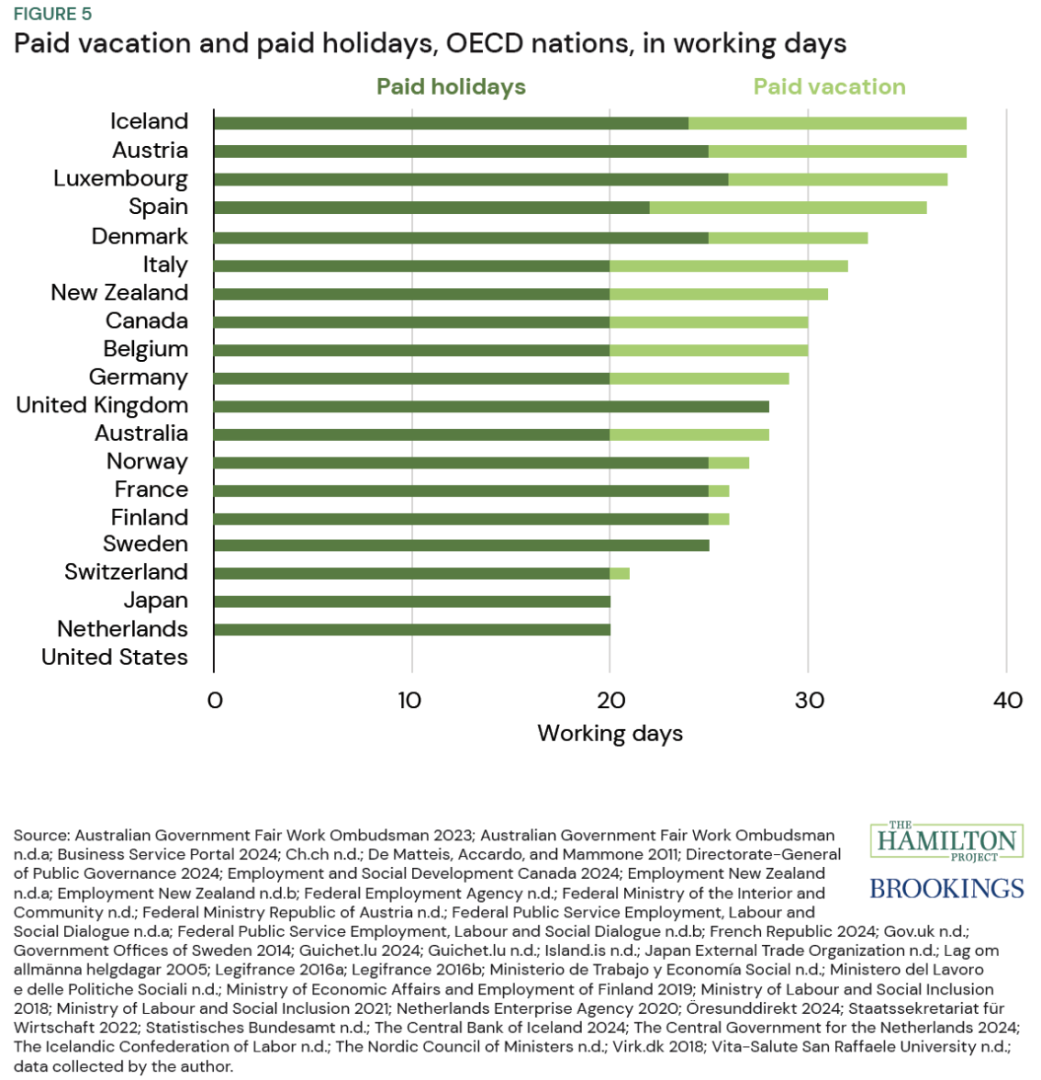A Federal Guarantee of Paid Vacation?
A Federal Guarantee of Paid Vacation?

The rules governing the US labor market are just different from other high-income countries in some way.
One difference involves paid time off. Here’s a figure from Betsey Stevenson, “A federal guarantee for earned paid time off” (Hamilton Project at the Brookings Institution, October 2024).
You will notice that in this comparison across various high-income countries, the US does not have a bar at all. Hmmm.

There various ways to respond to this table. One is to point out that the rules sketched here apply to full-time, full-year workers, and often only apply after the worker has been with an employer for several years. Stevenson writes:
These estimates report the statutory required number of paid leave days based on full-time, full-year workers. Many countries require a waiting period before paid leave becomes available. Canada and Japan have fewer days required for recent employees with the full amount of statutory leave being granted after several years of tenure with an employer. Only countries that statutorily require public holidays to be paid are listed as requiring paid holidays. However, in many countries that do not mandate pay for public holidays, workers often receive holidays off with pay or are compensated with another day off by custom or collective bargaining agreements.
Another way to respond is to wonder how these rules and laws about paid vacation and paid holidays interact with other kinds of paid leave. Stevenson notes that if we put together a graph with those kinds of leave, the US would still be the country with no bar at all on the graph: “In addition to these requirements for annual leave as part of employees’ compensation packages, most advanced economies also require additional amounts of paid sick leave. In addition, all advanced economies have national programs ensuring that people have access to paid family and medical leave …”
Stevenson sketches how a US policy along these lines might work: in her version, paid time off would accrue based on hours worked:
I propose that earned time off should accrue at a rate of one hour per 50 hours worked (2 percent of hours worked per week) in the first two years of the policy, increasing to one hour per 25 hours worked (4 percent of hours worked per week) after two years. In the first two years, workers must be able to accrue up to 40 hours a year; after two years, they must be able to accrue up to 80 hours a year. The reason for capping the earned leave is so that employers can simply offer full-time, full-year employees 80 hours a year (40 in the first two years), without needing to count hours. It is an administratively easy option.
Those interested in sorting through specific questions about such a policy will find a lot of answers in Stevenson’s article. Here, I’ll just note that there are roughly a jillion questions one might ask about a paid leave policy: for example, it’s not clear how it works for workers who change jobs frequently. Some high-income countries have developed an “insider/outsider” dynamic, where “insider” workers who have an attachment to a certain employer receive lots of benefits, but firms have an incentive to figure out ways of hiring that won’t make workers eligible for benefits, and a group of “outsider” workers develops without access to the benefits. I would worry that a paid leave policy will not actually be a guarantee for all workers, but instead will tend to leave out younger workers, as well as those with lower incomes and less connection to the labor force. In addition, labor market policies that work for much smaller countries (in the graph above, Iceland and Luxembourg each have a national population of less than 1 million) or countries with a much stronger tradition of unionization may not be well-suited for the enormous and widely varied US economy. US states, the “laboratories of democracy,” are already experimenting with various kinds of paid leave policies.
Of course, one answer to any practical questions about paid leave is that other countries have already in fact been doing it. But in addition, building political support for a paid leave policy in the United States is also a cultural issue. The typical American worker puts in more hours each year work more hours per year than workers in most other high-income countries; indeed, many American workers don’t take all of the paid vacation to which they are currently entitled. Stevenson argues:
Americans work more hours per year than workers in any other advanced country. Many Americans view hard work and long hours as a path to career advancement, personal fulfillment, and higher incomes. In a competitive job market, some Americans fear that taking too much time off could jeopardize their job security. They may worry about losing wages, falling behind, being replaced, or missing out on promotions and career advancement opportunities. Many employees have high workloads and believe that taking time off would lead to an unmanageable backlog of work. And, certainly many workers work long hours to make ends meet. In the U.S. there is a both a stigma against taking time off from work and no federal right to do so. … A national policy guaranteeing paid earned time off would shift attitudes toward time off from work and make earned paid time off a basic right for workers. In America, if you work hard and play by the rules, you should be able to afford to take a day off and not lose pay.
Timothy Taylor
Global Economy Expert
Timothy Taylor is an American economist. He is managing editor of the Journal of Economic Perspectives, a quarterly academic journal produced at Macalester College and published by the American Economic Association. Taylor received his Bachelor of Arts degree from Haverford College and a master's degree in economics from Stanford University. At Stanford, he was winner of the award for excellent teaching in a large class (more than 30 students) given by the Associated Students of Stanford University. At Minnesota, he was named a Distinguished Lecturer by the Department of Economics and voted Teacher of the Year by the master's degree students at the Hubert H. Humphrey Institute of Public Affairs. Taylor has been a guest speaker for groups of teachers of high school economics, visiting diplomats from eastern Europe, talk-radio shows, and community groups. From 1989 to 1997, Professor Taylor wrote an economics opinion column for the San Jose Mercury-News. He has published multiple lectures on economics through The Teaching Company. With Rudolph Penner and Isabel Sawhill, he is co-author of Updating America's Social Contract (2000), whose first chapter provided an early radical centrist perspective, "An Agenda for the Radical Middle". Taylor is also the author of The Instant Economist: Everything You Need to Know About How the Economy Works, published by the Penguin Group in 2012. The fourth edition of Taylor's Principles of Economics textbook was published by Textbook Media in 2017.
Trending
1 Are Theme Park Rides a Giffen Good?
Timothy Taylor2 UK Government Unveils New AI Assurance Platform to Boost Trust and Economic Growth
Fabrice Beaux3 London Internet Exchange Appoints Jennifer Holmes as New CEO
Fabrice Beaux4 Daylight Savings Time: Origins, Impacts, and Ongoing Debate
Anas Bouargane5 The Inflationists’ Narrative Is Crumbling
Daniel Lacalle

